The History Of FORD Sierra

The Ford Sierra is a large family car built by Ford Europe from 1982 until 1993. It was designed by Uwe Bahnsen, Robert Lutz and Patrick le Quément. The code used during development was "Project Toni".
Released on 21 September 1982, it replaced the Ford Cortina and Ford Taunus. Its aerodynamic styling was ahead of its time but many conservative buyers did not take fondly to the styling.
Possibly for this reason (and the fact that the smaller Escort was enjoying an increase in sales during the early 1980s), and the early lack of a saloon variant, it never quite achieved the sales volumes of the Cortina or the Taunus, although sales were still strong; a total of 2,700,500 Sierras were made,[citation needed] mainly manufactured in Germany, Belgium, and the United Kingdom, although Sierras were also assembled in Argentina, Venezuela, South Africa, and New Zealand.
The first Ford vehicle to have the bold new "aero" look styling was the 1981 Ford Probe III concept car. The good reception this received encouraged Ford management to go ahead with a production car with styling almost as challenging. This "aero" look influenced Fords worldwide; the 1983 Ford Thunderbird in North America introduced similar rounded, flowing lines, and some other new Fords of the time adopted the look. The aerodynamic features of the Sierra were developed from those first seen in the Escort Mark III — the "Aeroback" bootlid stump was proved to reduce the drag coefficient of the bodyshell significantly, which was a class leading 0.34 at its launch .
The aerodynamic styling of the Sierra would later be seen in North America's equally revolutionary Ford Taurus.
At first, many found the design blob-like and difficult to accept after being used to the sharp-edged, straight-line styling of the Cortina, and it picked up nicknames such as "Jellymould" and "The Salesman's Spaceship" (the latter thanks to its status as a popular fleet car in the United Kingdom). Sales were slow at first. It was later in the Sierra's life that the styling began to pay off; ten years after its introduction, the Sierra's styling was not nearly as outdated as its contemporaries, even though all major competitiors were newer designs, although the Sierra had been tweaked on several occasions. The most notable changes came at the start of 1987, with a major facelift the addition of a Sapphire saloon. As other manufacturers adopted similar aerodynamic styling, the Sierra looked more normal.
The revolutionary design and new name of the Cortina replacement attracted notable criticism on television from comedian Alexi Sayle, who blasted the Sierra for "not speaking English volumes" the way the Cortina had.
Early versions suffered from crosswind stability problems, which were addressed in 1985 with the addition of "strakes" (small spoilers), on the rear edge of the rubber seals of the rear most side windows. These shortcomings saw a lot of press attention, and contributed to early slow sales. Other rumours that the car hid major crash damage (in part true, as the new bumper design sprung back after minor impact and couldn't be "read" to interpret major damage) also harmed the car's reputation. This reached near-hysterical heights at one point with UK press making a report that Ford would reintroduce the previous Cortina model out of desperation. However, these reports were swiftly denied by Ford's overheads.
Styling was slightly different on the luxury "Ghia" and sporty "XR4i" models, which had a different front panel, with wider, double headlamps compared with the lower specified cars, and lacking their grille slats. After the model's mid-life facelift, the front without a grille became the standard look, although yet later a square grille panel would be re-introduced.
The Sierra was Ford's answer to the similar-sized Vauxhall Cavalier, which had been launched a year earlier with front-wheel drive and a hatchback bodystyle. Unusually in its sector by that time, the Sierra was still rear-wheel drive. It was a strong competitor for other rivals of the early 1980s, including the Talbot Alpine, Renault 18, Peugeot 305 and Morris Ital, but later in its life it had to compete with the Austin Montego (1984), Peugeot 405 (1987) and Mark III Vauxhall Cavalier (1988).
In another departure from tradition, the Sierra was initially unavailable as a saloon. At its launch it was available as a 5-door hatchback and a 5-door estate, and as a 3-door hatchback. Until the launch of the Orion in 1983, the larger and more expensive Granada was the only saloon-bodied car available in the European Ford range.
During the life of the car, two different styles of 3-door body were used; one with two pillars rear of the door, looking very much like a modified 5-door frame, as used on the high-performance XR4i; and a one-pillar design used on standard-performance 3-door hatchbacks and also at the other end of the scale as the basis for the very high-performance RS Cosworth. At the time of the car's launch, both styles were already envisaged, and a demonstration model with one style on either side was displayed at a Sierra design exhibition at the Victoria and Albert Museum in London.
The Ford Cortina had been manufactured in saloon and estate bodystyles but after the switch to the Sierra, combined with the redesign of the Ford Escort to Mark III level in 1980 and the introduction of the Ford Granada Mark III in 1985, Ford had changed its saloon-based line-up into a hatchback-based one.
The company launched the Ford Orion in 1983 to fill the gap in the saloon range between the late Cortina and the new Sierra. Ford found that customers were more attached to the idea of a saloon than they had expected, and this was further addressed in 1987 by the production of a saloon version of the Sierra. In the UK, this model was called the Ford Sierra Sapphire. This differed from the other Sierra models in having a traditional black grille, which only appeared in right hand drive markets. The 3-door Sierra was dropped in the UK in 1985, although the Cosworth version continued. Production of the 3-door Sierra continued in Europe, including after the Sierra range was given a facelift in 1987. The remodelled 3-door was never offered in the UK, having been withdrawn in 1984.
Initial drivetrain options
October 1982: introduction of the Sierra 5-door hatchback and 5-door estate range in the UK and consisting of:
- 1300 Base and 1300 L (1294 cc 60bhp (45kW) Taunus engine, available in standard or economy tune);
- 1600 Base, 1600 L, 1600 GL and 1600 Ghia (1593 cc 75bhp (56kW) engine, available in standard or economy tune);
- 2000 L Business, 2000 GL and 2000 Ghia (1993 cc 105bhp (78kW) engine);
- 2300 GL and 2300 Ghia (2294 cc, 114bhp (85kW) V6 engine);
- 2300 Base Diesel, 2300 L Diesel and 2300 GL Diesel (2304 cc, 67bhp (50kW) Peugeot Diesel engine);
- 2000 XR4i (150 bhp 1993 cc) (from 1983)
- 2800 / 2900 Xr4x4 (150/ 170 bhp 2792 cc / 2933 cc 'Cologne' V6) (from 1985)
- 2000 Cosworth (200/ 220 bhp YB) (from 1986)
1300, 1600 and 2000 engines all have a 4-speed manual gearbox; a 5-speed manual gearbox was optional with 1600 and 2000 engines, and standard with the 1600 Economy engine, the 2300 and 2300 Diesel. An optional 3-speed automatic transmission was available with 1600, 2000 and 2300 engines.
Sporting models utilized the 2.8 / 2.9 litre V6 engines coupled to a four wheel drive system (GLS4X4/ XR4x4) and, more notably the well known Cosworth model which was powered by a turbocharged 16 valve 4-cylinder engine known as the YB which was based on the Ford 'Pinto' block. The Ford Sierra Cosworth was first introduced in 1985 as a three door hatchback, with a 2 litre DOHC turbo engine producing 204bhp (152kW). At the time Ford wanted to compete in group A touring cars and therefore eligible to produce a limited run of 10% of the initial production, therefore this would be 500 cars. this was known as an 'evolution' model. Ford employed Tickford to help with the development. The Sierra RS500 as it was known sported a small additional rear spoiler, and larger front chin spoiler, extra cooling ducts for the engine, brakes and intercooler. Under the bonnet a larger turbo and intercooler was fitted along with an extra set of injectors, so instead of the standard four injectors it was built with eight, although in road trim these extra injectors did not function. These modifications produced 224bhp (167kW) in road trim and around 500bhp (370kW) in race trim. They were very successful in motorsport[citation needed] and are highly tunable road cars with a very large following.
In 1987, Ford introduced the Sierra Sapphire a four door saloon, which was sold alongside the hatchback and estate until the Sierra was replaced by the Mondeo in early 1993.
South Africa
In South Africa, the Sierra range featured both the hatchback and station wagon and production began at the Silverton (Pretoria)plant in 1985/ 6. The restyled Sierra range differed from its European equivalent by featuring the traditional black grille of the Sierra Sapphire sedan (known simply in South Africa as the Sapphire) on the hatchback and wagon. (Later, the grille would feature on these models in Europe.)
Versions sold in South Africa were available with 1.6 (Kent) and 2.0 (Cologne) 4-cylinder, 2.3 V6 (Cologne) or 3.0-litre V6 (Essex) petrol engines. While the Cortina MkV in South Africa had retained the old 3.0 V6 Essex engine, the Sierra was initially given the new 2.3 V6 Cologne motor, this being fitted to the top of the line model only. However, owing to the low cost of petrol, and the popularity of the old Cortina XR6, a Sierra XR6 was launched in 1986/ 7, featuring the old Essex, initially producing 103kW (138hp).
As the 2.8/ 2.9 Cologne was never launched in South Africa, the venerable and popular Essex V6 remained the best normal production engine fitted to the Sierra. At the top of the range, the 2.3 GLS quickly gave way to a 3.0 GLX flagship model (producing less power but more torque than the XR6) and that was the end of the Cologne in South Africa, even the station wagon receiving the 3.0 V6 Essex. By 1985, the Sierra had become the largest Ford model, following the demise of the Granada.
Towards the end of its production life, the Essex was modified again - the standard carb version tuned to produce 110kW (150PS; 148hp) from 1991 to 1993, while a fuel injected version was available from 1992 to 1993. Fitted to the Sierra as the 3.0i RS (replacing the XR6) and to the Sapphire sedan as the Sapphire Ghia (replacing the 3.0 GLX), the fuel-injected Essex put out around 117kW (157hp) and was the most powerful Sierra/ Sapphire version sold in South Africa, excluding the small number of XR8s built for homologation purposes (see next paragraph).
Uniquely, the South African market also saw the introduction of a 5.0L XR8 between 1986 and 1988. A limited number of 250 Sierras were made for the purposes of homolgation, as this model was the premier Ford used in Group N racing.
The 1.6 Kent continued almost unchanged during the 9 year life of the Sierra/ Sapphire, while the 2.0 Cologne was revised several times, being fitted to the Sierra 2.0 GL and GLE and later to the stripped down Sierra 2.0 LX and Sapphire 2.0 GL and GLE models. It eventually even received fuel injection in the Sapphire 2.0GLi, boosting the power from 77kW (103hp) to 85kW (114hp).
The Sierra was eventually replaced in South Africa by the Telstar in 1993. Samcor, which assembled Ford models under license after Ford had divested from the country, was already assembling the smaller Laser and Meteor, alongside the Mazda 323, on which they were based, as well as an earlier version of the Mazda 626. The Telstar was finally replaced by the Mondeo in 1998.
New Zealand
Whereas British buyers rued the absence of a saloon version of the Sierra, in New Zealand, it was the absence of an estate (a "station wagon" there) that customers missed, when Ford New Zealand replaced the Cortina with the Ford Telstar range. This led to Ford importing CKD ("completely knocked down") kits of the Sierra wagon for local assembly in 1984. The wagon was offered in 1.6 (base) and 2.0 litre "L" and "Ghia" models initially, and proved to be a strong seller. In one month in 1987, the facelifted Ford Sierra, by then a single station wagon model, was the country's top-selling car range.
However, Ford cancelled the Sierra once Mazda, which developed the Telstar, could offer a station wagon. The Telstar wagon, while popular, never reached the Sierra's heights, especially its competition successes overseas. Further reasons could be customers' knowledge of the Telstar's Japanese roots (European cars being perceived as superior, regardless of the Telstar's more modern mechanicals), and that the equivalent Mazda 626 wagon offered a considerably longer warranty at a similar price.
Relative rejection of the Telstar forced Ford to import completely built-up (CBU) premium models built in Genk, Belgium from 1990: the Sierra 2.0 GLX Wagon, the Sierra Sapphire 2.0 Ghia and the XR4×4 were part of this range. The advertising copy read, "Introducing the new car that needs no introduction." However, a relatively high price did not help – the Wagon began at over NZ$31,000 – and production errors in the launch brochure showed cars with no steering wheels. Furthermore, any marketing boosts Ford could have gained through Group A touring car racing were over with the Escort Cosworth becoming the company's standard-bearer in competition (and the Escort, meanwhile, was absent from the New Zealand market).
The Sierra was withdrawn from the New Zealand market in 1992, and it would be another five years before its European successor the Mondeo would arrive there.
By contrast, the Sierra was never sold in Australia, as there was less demand for a medium-sized wagon than in New Zealand, although the RS Cosworth/ RS500 was used in the Australian Touring Car Championships from the late 80's and early 90's.
South America
In South America, the Sierra was produced in Argentina and Venezuela. In Argentina, it was offered in three and five-door hatchback and station wagon bodystyles. The facelifted post-1987 model was built in Venezuela, but not in Argentina until 1989, where the range continued with a Merkur XR4Ti-like grille until 1991 for XR4 and 1992 for four door models, when it was replaced by the Volkswagen Santana-based Galaxy. The 1.6 L was offered in GL model only, LX, Ghia, Ghia SX and XR4 were based in a 2.3 engine with some differences. Some Ghia models also featured automatic transmission as an optional. The station wagon was called the Sierra Rural — "Rural" being used for Ford station wagons in Argentina in the same way "Turnier" is used in Germany.
GL model was the base model replaced by the LX with same equipment. XR4 was replaced by the 4-doors Ghia SX.
North America
Main article: Merkur XR4TiIn the USA, the Ford Sierra and the Ford Scorpio were offered under the failed Merkur brand. The Sierra was imported as a three door only, and called the XR4Ti (similar to sub-model designations in other markets). The Sierra name was not used by Ford in the US; the market had already seen the similar-sounding Oldsmobile Ciera, and the Sierra name was used by General Motors Corporation from the 1970s as a trim level on its pickup trucks.
The car was offered from the start of the Merkur brand in 1985 until 1989. It was equipped with a 2.3L variant of the SOHC "Pinto" engine, equipped with a turbocharger and fuel injection but no intercooler.
The Merkur brand is claimed to have been a commercial flop. The reasons vary. Safety and emissions regulations in the U.S. forced Ford to make costly modifications, resulting in relatively high prices. Exchange rates also fluctuated too frequently. Moreover, since Merkurs were sold at Lincoln-Mercury dealers, many customers were more attracted towards Mercury models because of their lower prices. Ironically, the XR4Ti outsold all the European XR variants combined, making it the most successful "XR" model.
Unlike many of its rivals, the Sierra retained rear wheel drive, albeit with a modern, fully independent rear suspension, departing from the Cortina's live axle.
In the beginning the Sierra used engines and transmissions from the Taunus / Cortina. The engines were of two types, the SOHC Ford Pinto engine in 1.3, 1.6, 1.8 and 2.0 L displacements, and the OHV Cologne V6 engine (in 2.3 and 2.8, rarely 2.9 L capacities). Towards the end of the 1980s due to tightening emission standards, the Pinto engine began to be phased out-the 1.8 in 1988 replaced by a 1.8 CVH, the 2.0 in 1989,replaced with the Ford I4 DOHC engine and the 1.6 in 1992,replaced by the 1.6 CVH first seen in the Escort in 1980, described as a "CFi", a single point fuel injection system with a catalytic converter.The 2.9 L Cologne engine was available in the Sierra XR4x4 and the rear wheel drive Sierra Ghia. Models with the 2.0 L and Cologne V6 engines had an option of a limited slip differential. Models built until 1989 used the type 9 gearbox that had been used in the Cortina, with the exception of 2WD Cosworth models that used the T5; it was later superseded by the MT75 unit (for DOHC, 4X4 and V6 models). All Sierras had rear drum brakes, except sporting models (2.0iS (some), XR4x4, Sierra Cosworth, other special/ sporting models inc 2.0i 4x4) and models with anti-lock brakes. American versions meanwhile were sold only with a 2.3 L four cylinder turbocharged version of the Pinto engine.
The Sierra also had a diesel option on the engine, namely at launch the 2.3L normally aspirated 67bhp (50kW; 68PS) Diesel made by Peugeot. This engine was also used in contemporary Granadas and whilst reliable and economical it made an unrefined, noisy and very slow vehicle, but remained a popular option for Taxi firms. This was later superseded in 1990 by a 1.8L turbocharged powerplant of Ford's own design which offered better response times and slightly more power.
In 1983, the high-performance XR4i version was introduced. It utilised the same 2.8 L Cologne engine as used in the Ford Capri 2.8 Injection of that era and sported a restyled version of the 3-door Sierra bodyshell. The double rear spoiler and curious multi-pillared rear windows were considered over-styled by some prospective buyers, and the car never achieved the cult status of the smaller Fiesta XR2 and Escort XR3i. A version of the XR4i with a 2.3 L turbocharged engine was sold in the United States as the Merkur XR4Ti. The XR4Ti was raced in Europe, most noticeably by Andy Rouse who used one to win the 1985 BTCC. In South Africa, there was a 3.0 L V6 version, called the XR6, while a limited run of 250 eight-cylinder XR8s were made in South Africa for saloon car racing homologation in 1984. These were based on the Ford Windsor 302 engine.
In 1985 the XR4i was replaced by the XR4x4, which was based on the five-door hatchback, had four wheel drive and was powered by the same 2.8 L V6 engine. By the end of its production in 1990, 23,540 had been produced. From 1990 to 1993 the XR4x4 was available with both the revised 2.9EFi and 2.0 DOHC EFi engines. The XR4i also made a reappearance (as a badging exercise) in 5-door form but with the DOHC 2.0 engine instead of the V6.
In 1989, Ford nodded towards its past and created the Sierra 2.0i 2000E, a model name used with limited success on the Mk3 Cortina. The Sierra 2000E had two-tone metallic paint, alloys and leather/ wood interior and was offered in saloon form. It was not a great sales success and was only a limited run.
In Argentina the non-injected XR4 model was equipped with the Taunus 2.3 engine and was produced between 1986 and 1991. In this market the most direct rival was the Renault Fuego 2.2.
In July 1986, a special version called the Ford Sierra RS Cosworth was launched, using a 204 hp (DIN) 2.0 L DOHC engine developed by Cosworth, with a Garret T3 turbocharger and intercooler. It was designed by Ford's Special Vehicle Engineering (SVE) group and made in Ford's Genk factory in Belgium for use in group A. It was based on a three-door Sierra with the dashboard from the Merkur XR4Ti. The car was available in only white, black or Ford's 'Moonstone Blue' and only 5545 were made.
In 1987, a 224bhp (167kW) Sierra Cosworth, the RS500, was sold alongside the 204hp (152kW) version. Only 500 were produced as the minimum number of road-going cars required to meet with newly introduced homologation racing rules, allowing it to compete in evolution form for group A racing. The car was modified by the Tickford Engineering Company in conjunction with Ford. Revisions included uprated brakes and larger brake cooling ducts and modified front and rear spoilers (a second smaller rear spoiler was added beneath the large "whale-tail"), a modified front bumper to allow extra cooling for a larger intercooler, as well as various engine upgrades including a larger turbocharger and a second fuel rail (which did not operate on road models). Race outputs were as high as 550bhp (410kW; 558PS), in which the Sierra dominated group A series around the world.
Racing versions of the Cosworth were highly successful in European and World touring car racing throughout the late 1980s and early 1990s', and the RS500 helped Ford to win the manufacturer's title in the 1987 World Touring Car Championship. Ford was forced to fall back on the Sierra for rallying from 1987, after the banning of the Group B formula. With only rear-drive, the Sierra struggled to compete on looser surfaces but was very quick on asphalt, Didier Auriol winning his first World Championship rally in a Sierra in Corsica, 1988. It was replaced by the 4x4 Sapphire version from 1990, which never managed to win a World Championship event but became a popular and successful car in national championships. The Sierra was replaced by the Escort Cosworth in 1993.
In 1988, a new Cosworth was produced which was based on the Sierra Sapphire saloon. 13,140 were produced until it was replaced in 1990 by a four wheel drive version, the Sierra Sapphire RS Cosworth 4x4, of which 12,250 were built. Its replacement came in the form of the Escort RS Cosworth which appeared in 1992, which used a shortened and developed version of the Sierra platform and running gear but clothed with an Escort-esque bodyshell and the return of the whale-tail spoiler.
Turbocharged versions of the Sierra were also available as post-production models from companies like Janspeed and, most notably, from Turbo Technics. The XR4x4 2.8 was available with a range of aftermarket kits pushing power from 150bhp (110kW) to 200/ 230/ 250 bhp. The 2.9 got a twin-turbo setup, available in 225/ 250/ 280 bhp variants. Even the DOHC version got a single turbo kit, of which only a small number were made. Turbo Technics even sold their own pre-prepared Sierra known as the Minker; only a handful were ever produced, as they cost significantly more than Ford's own RS Cosworth.
In Finland, tax laws made the 1.3 L-engined Sierra an attractive business car in the mid 1980s. A number of these underpowered engines were turbocharged by local Ford dealers in order to gain 2.0 L engine power with 1.3 L tax fees to the owner of the vehicle. The 1.6 L and 2.0 L OHC engines were also turbocharged. Some of these "Stockmann Turbo" Sierras, called so after a major dealer that made the conversions, are still running today.
In 1987, the Sierra was given some minor styling revisions (the windows were slightly enlarged, while the front fascia was tweaked), and a saloon (Ford Sierra Sapphire) version was introduced. Some detail styling changes were made in 1990, when the dashboard styling was freshened up, the front was given clear-lensed indicators, the rear given smoked rear lamp lenses, the steering wheel redesigned and a new front grille was added, together with fuel injection as standard, a new DOHC I4 engine (2.0 litre models), 15" wheels and rear disc brakes. A further revision to the interior trim (dash and door trimmings) and bumpers appeared for the 1992 line-up. UK production of the Sierra ceased, with right hand drive production moving to Belgium.
By the early 1990s, however, it had become clear that the Sierra had fallen out of step technologically against modern Japanese rivals which offered multi-valve engines, multi-link rear suspension and front wheel drive. All of these features appeared on the Sierra's long-awaited replacement, the Mondeo, which was unveiled at the end of 1992 and launched the following March.
From Wikipedia, the free encyclopedia
More About FORD Sierra
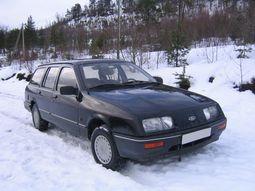
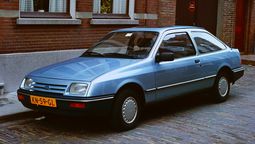
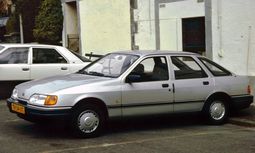

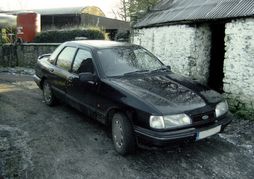
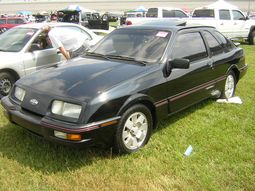

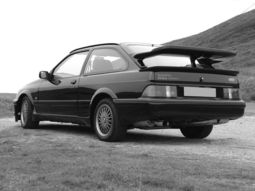
|